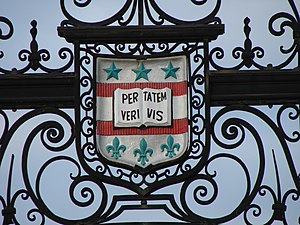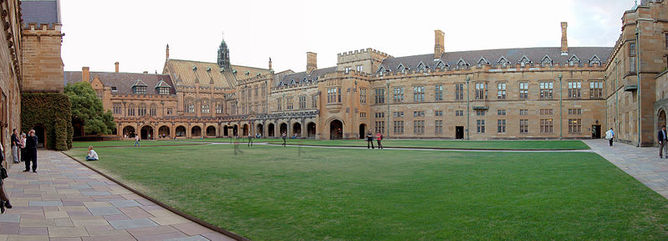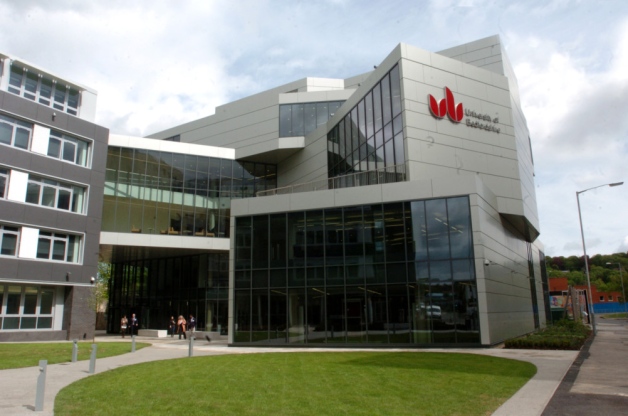UNIVERSITY OF WASHINGTON
Washington University in St. Louis (Wash. U., or WUSTL) is a privateresearch university located in St. Louis, Missouri, United States. Founded in 1853, and named after George Washington, the university has students and faculty from all 50 U.S. states and more than 120 countries.[8] Twenty-twoNobel laureates have been affiliated with Washington University, nine having done the major part of their pioneering research at the university.[9]Washington University's undergraduate program is ranked 15th by U.S. News and World Report.[10] The university is ranked 32nd in the world by theAcademic Ranking of World Universities.[11]
Washington University is made up of seven graduate and undergraduate schools that encompass a broad range of academic fields.[12] Officially incorporated as "The Washington University," the university is occasionally referred to as "WUSTL,"[pronunciation?] an acronym derived from its initials. More commonly, the school is referred to as "Wash. U." To prevent confusion over its location, the Board of Trustees added the phrase "in St. Louis" in 1976
History
Early history (1853–1900)
Washington University was conceived by 17 St. Louis business, political, and religious leaders concerned by the lack of institutions of higher learning in the Midwest. Missouri State Senator Wayman Crow and Unitarian minister William Greenleaf Eliot, grandfather of the poet T.S. Eliot, led the effort.
The university's first chancellor was Joseph Gibson Hoyt. Crow secured the university charter from the Missouri General Assembly in 1853, and Eliot was named President of the Board of Trustees. Early on, Eliot solicited support from members of the local business community, including John O'Fallon, but Eliot failed to secure a permanent endowment. Washington University is unusual among major American universities in not having had a prior financial endowment. The institution had no backing of a religious organization, single wealthy patron, or earmarked government support.
During the three years following its inception, the university bore three different names. The board first approved "Eliot Seminary," but William Eliot was uncomfortable with naming a university after himself and objected to the establishment of a seminary, which would implicitly be charged with teaching a religious faith. He favored a nonsectarian university.[14] In 1854, the Board of Trustees changed the name to "Washington Institute" in honor of George Washington. Naming the University after the nation's first president, only seven years before the American Civil War and during a time of bitter national division, was no coincidence. During this time of conflict, Americans universally admired George Washington as the father of the United States and a symbol of national unity. The Board of Trustees believed that the university should be a force of unity in a strongly divided Missouri. In 1856, the University amended its name to "Washington University." The university amended its name once more in 1976, when the Board of Trustees voted to add the suffix "in St. Louis" to distinguish the university from the nearly two dozen other universities bearing Washington's name.[13]
Although chartered as a university, for many years Washington University functioned primarily as a night school located on 17th Street and Washington Avenue in the heart of downtown St. Louis. Owing to limited financial resources, Washington University initially used public buildings. Classes began on October 22, 1854, at the Benton School building. At first the university paid for the evening classes, but as their popularity grew, their funding was transferred to the St. Louis Public Schools.[15] Eventually the board secured funds for the construction of Academic Hall and a half dozen other buildings. Later the university divided into three departments: the Manual Training School, Smith Academy, and the Mary Institute.
In 1867, the university opened the first private nonsectarian law school west of the Mississippi River. By 1882, Washington University had expanded to numerous departments, which were housed in various buildings across St. Louis. Medical classes were first held at Washington University in 1891 after the St. Louis Medical College decided to affiliate with the University, establishing the School of Medicine. During the 1890s, Robert Sommers Brookings, the president of the Board of Trustees, undertook the tasks of reorganizing the university's finances, putting them onto a sound foundation, and buying land for a new campus.
Modern era (1900–1955)
Washington University spent its first half century in downtown St. Louis bounded by Washington Ave., Lucas Place, and Locust Street. By the 1890s, owing to the dramatic expansion of the Manual School and a new benefactor in Robert Brookings, the University began to move west. The University Board of Directors began a process to find suitable ground and hired the landscape architecture firm Olmsted, Olmsted & Eliot of Boston. A committee of Robert S. Brookings, Henry Ware Eliot, and William Huse found a site of 103 acres (41.7 ha) just beyond Forest Park, located west of the city limits in St. Louis County. The elevation of the land was thought to resemble the Acropolis and inspired the nickname of "Hilltop" campus, renamed the Danforth campus in 2006 to honor former chancellor William H. Danforth.
In 1899, the university opened a national design contest for the new campus. The renowned Philadelphia firm Cope & Stewardson won unanimously with its plan for a row of Collegiate Gothicquadrangles inspired by Oxford and Cambridge Universities.[16] The cornerstone of the first building, Busch Hall, was laid on October 20, 1900. The construction of Brookings Hall, Ridgley, and Cupples began shortly thereafter. The school delayed occupying these buildings until 1905 to accommodate the 1904 World's Fair and Olympics. The delay allowed the university to construct ten buildings instead of the seven originally planned. This original cluster of buildings set a precedent for the development of the Danforth Campus; Cope & Stewardson’s original plan and its choice of building materials have, with few exceptions, guided the construction and expansion of the Danforth Campus to the present day.[16]
By 1915, construction of a new medical complex was completed on Kingshighway in what is now St. Louis’s Central West End. Three years later, Washington University admitted its first women medical students.
In 1922, a young physics professor,Arthur Holly Compton, conducted a series of experiments in the basement of Eads Hall that demonstrated the "particle" concept of electromagnetic radiation. Compton’s discovery, known as the “Compton Effect,” earned him the Nobel Prize in physics in 1927.
During World War II, as part of theManhattan Project, a cyclotron at Washington University was used to produce small quantities of the newly discovered element plutonium via neutron bombardment of uranium nitrate hexahydrate. The plutonium produced there in 1942 was shipped to the Metallurgical Laboratory Compton had established at the University of Chicago where Glenn Seaborg's team used it for extraction, purification, and characterization studies of the exotic substance.
After working for many years at the University of Chicago, Arthur Holly Compton returned to St. Louis in 1946 to serve as Washington University's ninth chancellor. Compton reestablished the Washington University football team, making the declaration that athletics were to be henceforth played on a "strictly amateur" basis with no athletic scholarships. Under Compton’s leadership, enrollment at the University grew dramatically, fueled primarily by World War II veterans' use of their GI Bill benefits.[18]
In 1947, Gerty Cori, a professor at the School of Medicine, became the first American woman to win a Nobel Prize in Physiology or Medicine. Professors Carl and Gerty Cori became Washington University's fifth and sixth Nobel laureates for their discovery of how glycogen is broken down and resynthesized in the body.
The process of desegregation at Washington University began in 1947 with the School of Medicine and the School of Social Work. During the mid and late 1940s, the University was the target of critical editorials in the local African American press, letter-writing campaigns by churches and the local Urban League, and legal briefs by the NAACP intended to strip its tax-exempt status. In spring 1949, a Washington University student group, the Student Committee for the Admission of Negroes (SCAN), began campaigning for full racial integration. In May 1952, the Board of Trustees passed a resolution desegregating the school's undergraduate divisions.
Recent history (1955–present)
During the latter half of the 20th century, Washington University transitioned from a strong regional university to a national research institution. In 1957, planning began for the construction of the “South 40,” a complex of modern residential halls. With the additional on-campus housing, Washington University, which had been predominantly a “streetcar college” of commuter students, began to attract a more national pool of applicants. By 1964, over two-thirds of incoming students came from outside the St. Louis area.
In 1971, the Board of Trustees appointed ChancellorWilliam Henry Danforth, who guided the university through the social and financial crises of the 1970s and strengthened the university’s often strained relationship with the St. Louis community. During his 24-year chancellorship, Danforth significantly improved the School of Medicine, established 70 new faculty chairs, secured a $1.72 billion endowment, and tripled the amount of student scholarships.
In 1995, Mark S. Wrighton, former Provost at MIT, was elected the university’s 14th chancellor. During Chancellor Wrighton's tenure undergraduate applications to Washington University have more than doubled. Since 1995, the University has added more than 190 endowed professorships, revamped its Arts & Sciences curriculum, and completed more than 30 new buildings.
The growth of Washington University’s reputation has coincided with a series of record-breaking fund-raising efforts during the last three decades. From 1983 to 1987, the “Alliance for Washington University” campaign raised $630.5 million, which was then the most successful fund-raising effort in national history.From 1998 to 2004, the “Campaign for Washington University” raised $1.55 billion, which has been applied to additional scholarships, professorships, and research initiatives.
U.S. presidential and vice-presidential debates
Washington University has been selected by the Commission on Presidential Debates to host more presidential and vice-presidential debates than any other institution in history.] United States presidential election debates were held at the Washington University Athletic Complex in 1992, 2000, 2004, and 2016. A presidential debate was planned to occur in 1996, but owing to scheduling difficulties between the candidates, the debate was canceled.[The university hosted the only 2008 vice presidential debate, between Republican Sarah Palin andDemocrat Joe Biden, on October 2, 2008, also at the Washington University Athletic Complex.
Although Chancellor Wrighton had noted after the 2004 debate that it would be "improbable" that the university will host another debate and was not eager to commit to the possibility,[29] he subsequently changed his view and the university submitted a bid for the 2008 debates. "These one-of-a-kind events are great experiences for our students, they contribute to a national understanding of important issues, and they allow us to help bring national and international attention to the St. Louis region as one of America's great metropolitan areas," said Wrighton.













0 Comments